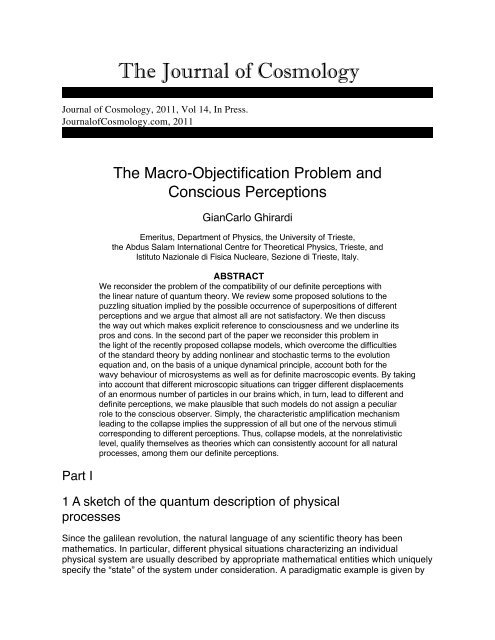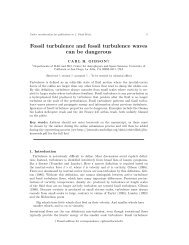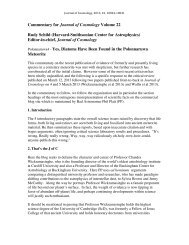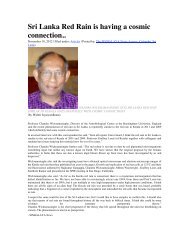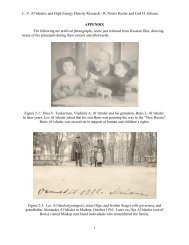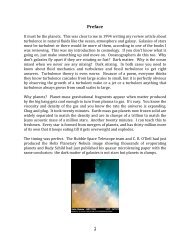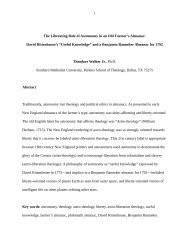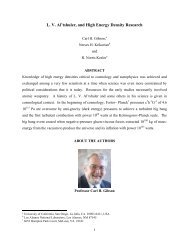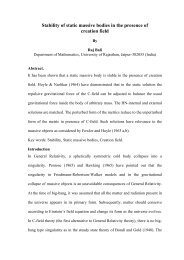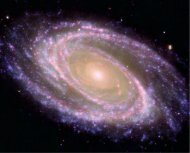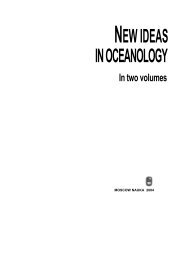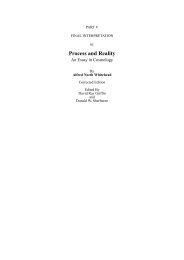The Macro-Objectification Problem and Conscious Perceptions
The Macro-Objectification Problem and Conscious Perceptions
The Macro-Objectification Problem and Conscious Perceptions
You also want an ePaper? Increase the reach of your titles
YUMPU automatically turns print PDFs into web optimized ePapers that Google loves.
<strong>The</strong> Journal of Cosmology<br />
Journal of Cosmology, 2011, Vol 14, In Press.<br />
JournalofCosmology.com, 2011<br />
Part I<br />
<strong>The</strong> <strong>Macro</strong>-<strong>Objectification</strong> <strong>Problem</strong> <strong>and</strong><br />
<strong>Conscious</strong> <strong>Perceptions</strong><br />
GianCarlo Ghirardi<br />
Emeritus, Department of Physics, the University of Trieste,<br />
the Abdus Salam International Centre for <strong>The</strong>oretical Physics, Trieste, <strong>and</strong><br />
Istituto Nazionale di Fisica Nucleare, Sezione di Trieste, Italy.<br />
ABSTRACT<br />
We reconsider the problem of the compatibility of our definite perceptions with<br />
the linear nature of quantum theory. We review some proposed solutions to the<br />
puzzling situation implied by the possible occurrence of superpositions of different<br />
perceptions <strong>and</strong> we argue that almost all are not satisfactory. We then discuss<br />
the way out which makes explicit reference to consciousness <strong>and</strong> we underline its<br />
pros <strong>and</strong> cons. In the second part of the paper we reconsider this problem in<br />
the light of the recently proposed collapse models, which overcome the difficulties<br />
of the st<strong>and</strong>ard theory by adding nonlinear <strong>and</strong> stochastic terms to the evolution<br />
equation <strong>and</strong>, on the basis of a unique dynamical principle, account both for the<br />
wavy behaviour of microsystems as well as for definite macroscopic events. By taking<br />
into account that different microscopic situations can trigger different displacements<br />
of an enormous number of particles in our brains which, in turn, lead to different <strong>and</strong><br />
definite perceptions, we make plausible that such models do not assign a peculiar<br />
role to the conscious observer. Simply, the characteristic amplification mechanism<br />
leading to the collapse implies the suppression of all but one of the nervous stimuli<br />
corresponding to different perceptions. Thus, collapse models, at the nonrelativistic<br />
level, qualify themselves as theories which can consistently account for all natural<br />
processes, among them our definite perceptions.<br />
1 A sketch of the quantum description of physical<br />
processes<br />
Since the galilean revolution, the natural language of any scientific theory has been<br />
mathematics. In particular, different physical situations characterizing an individual<br />
physical system are usually described by appropriate mathematical entities which uniquely<br />
specify the “state” of the system under consideration. A paradigmatic example is given by
Newtonian mechanics: the state of a system is uniquely specified by the assignment of<br />
the positions <strong>and</strong> velocities of all its constituents. Besides the states, a crucial role is<br />
played by the physically observable quantities, such as the momentum, the energy <strong>and</strong> so<br />
on. In classical mechanics these quantities are simply functions of the positions <strong>and</strong> the<br />
velocities of the constituents <strong>and</strong>, as such, they always possess precisely definite values.<br />
Finally, any theory must have a predictive character. This is usually embodied in an<br />
evolution equation for the “state” of the system which uniquely assigns a state at any<br />
time t once the initial state (at time 0) is specified. Obviously the formal scheme must<br />
also contain the prescription which, once the state is known, allows one to infer the value<br />
he will get when subjecting the system to a “measurement” of the physical observable he<br />
is interested in.<br />
To supply, in a quite elementary way, the reader who is not familiar with quantum theory<br />
with the formal elements which are necessary to underst<strong>and</strong> what follows, we consider<br />
it appropriate to summarize the “rules of the game” in the case of quantum mechanics.<br />
In reading this section it may be useful to give a look at Fig.1 which puts in evidence all<br />
formal aspects we are going to describe, by making reference to the oversimplified case of<br />
a linear vector space of dimension 2.<br />
• <strong>The</strong> states of the system are associated to normalized (i.e. of length 1) vectors<br />
(which, for this reaason are also called statevectors) of a linear vector space. Let<br />
us denote, following Schrödinger, as |ψ〉, |φ〉 two such states. <strong>The</strong> linear nature of<br />
the space of the states implies that if the two just mentioned states are possible<br />
states for a system, then also any normalized combination of them with complex<br />
coefficients α|ψ〉 + β|φ〉, |α| 2 + |β| 2 = 1 is also a possible state of the system.<br />
• <strong>The</strong> physical observables of the system are associated to appropriate operators acting<br />
on the state space. Here, an extremely important <strong>and</strong> innovative aspect of<br />
the formalism consists in the emergence of the phenomenon of quantization: the<br />
physical observables (in general) cannot assume any value in appropriate continuos<br />
intervals (as it happens in classical physicis) but they can take only some discrete<br />
values, called eigenvalues, which are the values for which the eigenvalue equation,<br />
Eq.(1) below, admits a solution. If we denote as Ω the operator corresponding,<br />
within quantum mechanics, to an appropriate classical observable (like the angular<br />
momentum <strong>and</strong> similar) then we must look for values ωi <strong>and</strong> states |φi〉 satisfying:<br />
Ω|φi〉 = ωi|φi〉. (1)<br />
<strong>The</strong> eigenvalues ωi (due to some precise formal requests on the operators representing<br />
observables) turn out to be real, they are usually discrete, the eigenvectors<br />
turn out to be pairwise ortogonal <strong>and</strong>, as a set of states, they are “complete”, a<br />
technical expression to stress that any vector of the space can be expressed as a<br />
linear combination of them. Accordingly, the eigenstates of an observable yield an<br />
orthogonal system of axes for the space itself.<br />
• <strong>The</strong> evolution equation is a deterministic differential equation, the celebrated Schrödinger’s<br />
equation. Its most relevant feature, for what interests us here is that it is<br />
2
linear, i.e., if |ψ, 0〉 <strong>and</strong> |φ, 0〉 are two initial states <strong>and</strong> |ψ, t〉 <strong>and</strong> |φ, t〉 are their<br />
evolved at time t, then the evolved of the initial state α|ψ, 0〉 + β|φ, 0〉 is α|ψ, t〉 +<br />
β|φ, t〉.<br />
• <strong>The</strong> predictions of the theory are fundamentally probabilistic <strong>and</strong> are embodied in<br />
the following rule. If the system is described by the state |Ψ〉 <strong>and</strong> if one is interested<br />
in the predictions concerning the outcome of a measurement of an observable Ω, one<br />
must express the state as a linear combination of the eigenstates of the observable<br />
itself (something we know that is always possible):<br />
|Ψ〉 = <br />
ci|φi〉. (2)<br />
i<br />
<strong>The</strong>n the theory makes precise probabilistic predictions concerning any outcome,<br />
let us say ωk, which one can get in a measurement of Ω (<strong>and</strong> the same procedure<br />
allows to determine the probabilities of the outcomes for the other observables).<br />
Actually, the probability P(Ω = ωk||Ψ〉) of such an outcome for such an observable<br />
when the system is in the indicated state is simply given by the modulus square<br />
of the corresponding coefficient ck of Eq.(2) (Note that since the vector has length<br />
one the sum of the squares of all its components equals one, i.e., one of the possible<br />
outcomes is obtained with certainty). From this rule one sees that when one <strong>and</strong><br />
only one of the ci’s is different from zero (<strong>and</strong> therefore it equals 1) we can predict<br />
with certainty the outcome itself. In such a case we say that the observable Ω,<br />
possesses with certainty the value ωk.<br />
• It has to be stressed that, in general, different operators do not commute ΩΓ = ΓΩ.<br />
<strong>The</strong> most relevant implication of this fact is that, in general, the eigenvectors of a<br />
pair of such operators are not aligned. This means that if one prepares the system<br />
in a state that corresponds to a definite value of an observable (<strong>and</strong> therefore it is an<br />
eigenstates of the observable itself) the corresponding statevector will have non zero<br />
projections on at least two (in general many) eigenstates of the other noncommuting<br />
observable. As a consequence there are nonzero probabilities of getting one among<br />
various outcomes for it: the considered variable does not have a precise value.<br />
Accordingly, making sharp the value of an observable makes indefinite the value of<br />
other observables.<br />
This is the uncertainity principle which holds, in particular, between the position<br />
<strong>and</strong> momentum variables: the more precise we make one of the two observables, the<br />
less precise we make the other.<br />
It has to be stressed that if we consider a set of observables which commute among<br />
themselves (a set having this property is called an abelian set) then a theorem<br />
ensures that they admit precisely the same eigenstates. <strong>The</strong>re obviously follows<br />
that, when such a common eigenstate describes the state of the system, all the<br />
considered observables possess precisely definite values.<br />
• <strong>The</strong> theory specifies also the effect of the measurement process: if we make a system<br />
in a state like the one of Eq.(2) (with various ci different from zero), to interact with<br />
3
the measuring apparatus, <strong>and</strong> we obtain the outcome, let us say ωj, the state of<br />
the system changes instantaneously from |Ψ〉 to the eigenstate corresponding to the<br />
eigenvalue of the measured observable: |Ψ〉 → |φj〉. Note that, contrary to the<br />
st<strong>and</strong>ard evolution, which is linear <strong>and</strong> deterministic, the change induced by the<br />
measurement process is nonlinear (since the probabilities are given by the squares<br />
of the moduli of the coefficients) <strong>and</strong> stochastic (since all outcomes corresponding<br />
to non zero coefficients may occur with the specified probabilities).<br />
σ =-1<br />
x<br />
δ<br />
σ =-1<br />
z<br />
β<br />
α<br />
|Ψ><br />
γ<br />
σ =+1<br />
x<br />
σ =+1<br />
z<br />
Figure 1: <strong>The</strong> formal structure of quantum mechanics in a pictorial form.<br />
As already anticipated, we have chosen to depict, in Fig.1, the situation we have just<br />
described by making reference to the simplest vector space which occurs in the theory, the<br />
one related to the spin degree of freedom of a spin 1/2 particle. In such a case the vector<br />
space is two dimensional. Moreover, the observables corresponding to the projections of<br />
the spin along any given direction can take only the values ±1, in units of h/2π, h being<br />
Planck’s constant.<br />
Each operator corresponding to the spin component in a given direction is uniquely<br />
associated to two orthogonal unit vectors, its eigenstates. <strong>The</strong>se vectors are different<br />
for different directions. In the figure, we have indicated the state |Ψ〉 associated to the<br />
system, <strong>and</strong> two pairs of orthogonal axes (the horizontal <strong>and</strong> vertical ones <strong>and</strong> those at<br />
45 0 <strong>and</strong> 135 0 degrees). <strong>The</strong>y correspond to the observables σz, the projection of the spin<br />
along the z-axis (in the indicated units), <strong>and</strong> σx, the projection of the spin along the xaxis,<br />
respectively. From the figure one can grasp all relevant points of the formalism: the<br />
modulus square of the components α (β) of the statevector along the horizontal (vertical)<br />
axis give the probability of getting the outcome +1 (−1) when the spin is measured along<br />
the z-axis. Similarly, the modulus square of γ <strong>and</strong> δ yield the probabilities of getting the<br />
two above mentioned outcomes in a measurement of the spin component along the x-axis.<br />
As one clearly sees, making precise <strong>and</strong> equal to +1, e.g., the value of the spin component<br />
along the x-axis, which means aligning the statevector |Ψ〉 with the line at 45 0 ,<br />
implies, since this unit vector has components 1/ √ 2 along the horizontal <strong>and</strong> vertical<br />
axes that, for such a state, there is a probability 1/2 of getting the outcome +1 or −1<br />
in the measurement of the z-spin component. Making absolutely precise one observable,<br />
i.e. σx, renders thus maximally indeterminate the other one since equal probabilities are<br />
4
attached to its two possible outcomes. We also recall that, within the st<strong>and</strong>ard theory, a<br />
measurement changes instantaneously the state of the system. In our case, if we measure<br />
the x-component of the spin <strong>and</strong> we get the result +1, the statevector |Ψ〉 is transformed<br />
into the unit vector at 45 0 .<br />
2 <strong>The</strong> position representation<br />
To allow the reader to follow the discussion in the second part of the paper we are<br />
compelled to make an important specification: not all observable quantities are quantized,<br />
some of them can take any value within a continuous interval. This implies some formal<br />
mathematical refinements which we will not discuss in detail. Typical examples of this<br />
situation are the position <strong>and</strong> the momentum observables; both of them can assume, just<br />
as in classical mechanics, all values lying between −∞ <strong>and</strong> +∞. Let us consider the<br />
analogous, in the continuous case, of the discrete case discussed above. For the moment,<br />
let us assume that we are dealing with a one-dimensional problem, i.e. a particle moving<br />
along a line, <strong>and</strong> let’s denote as X its position variable.<strong>The</strong> eigenvalue equation (1) will<br />
be replaced by:<br />
X|x〉 = x|x〉, (3)<br />
x being the value of the position occupied by the particle, while Eq.(2) will be replaced<br />
by:<br />
|Ψ〉 =<br />
+∞<br />
−∞<br />
|ψ(x)| 2<br />
dxψ(x)|x〉. (4)<br />
Figure 2: <strong>The</strong> probability of finding the particle within the interval ∆ is given by the black area in the<br />
figure.<br />
It is important to clarify the physical meaning of the coefficient (the wavefunction)<br />
ψ(x) appearing in this equation. First of all, the normalization condition (the fact that<br />
|Ψ〉 has length 1) now reads:<br />
+∞<br />
−∞<br />
Δ<br />
x<br />
dx|ψ(x)| 2 = 1. (5)<br />
Secondly, just as the squares of the moduli of the coefficients ci give the probabilities of<br />
getting the outcome ωi in a measurement of the observable Ω, now the modulus square<br />
of the wavefunction |ψ(x)| 2 yields the probability density of finding the particle at x in<br />
a position measurement. Physically this means that the area subtended by the modulus<br />
5
square of this quantity in a given interval ∆ of the x-axis, gives the probability of finding<br />
the particle in the indicated interval when subjected to a position measurement. We have<br />
depicted the situation in Fig.2.<br />
3 <strong>The</strong> quantum measurement problem<br />
With the above premises, we can now formulate in a precise way the quantum measurement<br />
problem. <strong>The</strong> idea is quite simple. Suppose we have a microscopic system in an<br />
eigenstate of a specific observable, <strong>and</strong> we want to ascertain its value, which, as we know,<br />
coincides with certainty with the associated eigenvalue. If we denote as usual as |φi〉 the<br />
eigenstate of the micro-observable Ω we are interested in, <strong>and</strong> we assume that we can get<br />
knowledge of its definite value ωi, we must consider an apparatus A characterized by a<br />
“ready state” |A0〉 <strong>and</strong> a micro-macro interaction leading to the evolution:<br />
|φi〉 ⊗ |A0〉 → |φi〉 ⊗ |Ai〉, (6)<br />
where the macrostates |Ai〉 are macroscopically <strong>and</strong> perceptually disinguishable. <strong>The</strong><br />
st<strong>and</strong>ard example is the one of a macroscopic pointer that, after the measurement, will<br />
“point” at the obtained value i.<br />
Equation (6) deserves some comments. In it the product of two states, referring to<br />
two different systems appears (the use of the circled cross makes reference to the formal<br />
fact that the space of the composite system is the direct product of the spaces of the<br />
constituents). However, from a physical point of view, the states appearing in Eq.(6)<br />
have a precise meaning: at the l.h.s we have a microsystem in the state which corresponds<br />
to its having the precise value ωi for an appropriate observable, while the macroscopic<br />
apparatus is in a “ready” state in which its pointer points at 0. Concerning the state at<br />
the r.h.s. the microsystem is in the same state <strong>and</strong> still has the property Ω = ωi, while<br />
the macroscopic pointer is also in a definite, different from the previous one, state: its<br />
pointer points at i on the scale. We have ascertained the possessed value of the observable<br />
Ω.<br />
Here comes the problem. In fact we can easily prepare the microsystem in a state<br />
which, instead of being an eigenstate of the observable we are interested in, is a linear superposition<br />
of eigenstates belonging to different eigenvalues (the reader should remember<br />
that the eigenstate of the σx component of the spin associated to the eigenvalue +1 is a<br />
linear superposition, with equal coefficients of the two eigenstates of σz belonging to the<br />
eigenvalues +1 <strong>and</strong> −1). Moreover, we can put the microsystem in such a superposition<br />
into interaction with the macroapparatus designed to “measure” Ω. At this point we are<br />
in troubles since we can argue as follows. <strong>The</strong> unfolding of the process which implies<br />
the micro-macro (system-apparatus) interaction must be governed by our fundamental<br />
theory, quantum mechanics. In fact, what reason whatsoever there could be for all microconstituents<br />
of the universe to be governed by the quantum laws, while a macrosystem,<br />
which is nothing more than an assembly of nuclei, atoms, molecules <strong>and</strong> so on, should<br />
be ruled by different laws? However, as we have repeatedly stressed, due to the linear<br />
character of the evolution, if the microsystem-macroapparatus interaction is described by<br />
6
Eq.(6) when the triggering state is an eigenstate of the observable Ω, then, in the present<br />
case, one has:<br />
<br />
ci|φi〉 ⊗ |A0〉 ≡ <br />
ci[|φi〉 ⊗ |A0〉] → <br />
ci|φi〉 ⊗ |Ai〉. (7)<br />
i<br />
i<br />
<strong>The</strong> final state is not a product (factorized) state of the system <strong>and</strong> the apparatus, but<br />
a linear superposition of such states. Technically it is referred as an entangled systemapparatus<br />
state. <strong>The</strong> puzzle arises from the fact that, as the theory tells us, such a<br />
state does not describe neither a microsystem with a definite property for Ω (<strong>and</strong> this is<br />
not particularly problematic) nor a macroscopic object whose pointer points at a precise<br />
position. Actually the theory implies that the pointer “does not have a precise location”<br />
<strong>and</strong> only if we decide to “measure its position” we will get one of the potentially possible<br />
outcomes: the pointer will be found to point at, let us say, k. Which meaning can be<br />
attached to a state in which a superposition of macroscopically <strong>and</strong> perceptually different<br />
states appears? How to interpret this state of affairs?<br />
As we have already anticipated, the “orthodox” way out is to claim that the final<br />
situation is described, with probability |ci| 2 , by one of the terms of the superposition,<br />
all of which correspond to the pointer “pointing at a precise position”. So, st<strong>and</strong>ard<br />
quantum mechanics contains two evolution laws, the linear one typical of microsystems<br />
<strong>and</strong> the nonlinear <strong>and</strong> stochastic one corresponding to Wave Packet Reduction (WPR),<br />
<strong>and</strong> accounting for the measurement processes. <strong>The</strong> big problem derives from the fact<br />
that the theory does not contain any formal element which identifies when one or the<br />
other type of evolution occur. Actually, macroscopic systems which require a genuinely<br />
quantum treatment exist. <strong>The</strong> problem has been emphasized with admirable lucidity by<br />
the late J. Bell:<br />
Nobody knows what quantum mechanics says exactly about any situation, for<br />
nobody knows where the boundary really is between wavy quantum systems <strong>and</strong><br />
the world of particular events.<br />
4 <strong>The</strong> von Neumann chain<br />
John von Neumann has been the first to dig deeply into the measurement problem. He<br />
made an important remark. If one takes into account Eq.(7), one cannot consider it as<br />
exhaustively describing the measurement process. In fact, as it is obvious, the final state<br />
leads to the natural question: what actually is the outcome of the measurement? (i.e.<br />
where does the pointer point?). <strong>The</strong> answer is obvious: we must consider a further process<br />
aimed to ascertain which one of the eigenstates |Ai〉 actually occurred. In this way the<br />
so-called von Neumann’s chain finds its origin. <strong>The</strong> r.h.s of Eq.(7) must be enriched by<br />
taking into account the further measuring apparatus (let us call it B) devised to identify<br />
in which of the macrostates the pointer A is. Accordingly, we must consider successive<br />
measurement procedures aiming to identify what the actual state of affairs is:<br />
<br />
ci|φi〉 ⊗ |A0〉 ⊗ |B0〉 ⊗ .... → <br />
ci|φi〉 ⊗ |Ai〉 ⊗ |Bi〉 ⊗ ...., (8)<br />
i<br />
7<br />
i<br />
i
<strong>and</strong> so on. <strong>The</strong> chain never ends but it exhibits a quite interesting feature. No matter<br />
at which point one chooses to break it, if the linear superposition is replaced by one of<br />
its terms (let us say the ith) one gets a consistent set of outcomes: the particle is found<br />
in state |φi〉, the macroapparatus has its macroscopic pointer pointing at the value i of<br />
the scale, the apparatus B reveals that the macroapparatus A actually points at i <strong>and</strong> so<br />
on. In brief, there is a full “final” consistency provided one breaks (at a certain level) the<br />
chain.<br />
Some remarks are at order:<br />
• This approach leaves open the stage at which the breaking must be assumed to<br />
occur, provided it occurs at some point. In this sense, it is not surprising that von<br />
Neumann <strong>and</strong> Wigner have chosen (see below) to break it at the level in which<br />
consciousness enters into play.<br />
• von Neumann’s has tacitly made some quite drastic assumptions concerning the<br />
unfolding of the process (typically that the measurement has 100% efficiency, that<br />
the final states are strictly ortogonal etc., a set of assumptions which are very<br />
difficult to be verified in actual experiments) <strong>and</strong> this is why one usually refers to<br />
the just described scheme as “<strong>The</strong> Ideal von Neumann’s Measurement Process”.<br />
5 <strong>The</strong> unavoidability of the problem<br />
Some authors (Primas, 1990) have suggested that the previous argument arises from<br />
having described the measurement process by a too idealized scheme. That this is not<br />
the case has been proved in absolute generality in a recent paper (Bassi & Ghirardi,<br />
2000), in which it has been shown that, if quantum mechanics has unrestricted validity,<br />
the occurrence of the embarrassing superpositions of macroscopically <strong>and</strong> perceptually<br />
different states of macrosystems cannot be avoided.<br />
<strong>The</strong> original paper by Bassi <strong>and</strong> Ghirardi has given rise to a stimulating debate with<br />
B. d’Espagnat: (d’Espagnat, 2001). <strong>The</strong> relevant conclusion of this author, for what<br />
concerns us here, is:<br />
What Bassi & Ghirardi has proved is that we must either accept the break [ i.e.<br />
to ab<strong>and</strong>on the superposition principle] or grant that man-independent reality<br />
- to the extent that this concept is meaningful - is something more “remote<br />
from anything ordinary human experience has access to” than most scientists<br />
were up to now prepared to believe.<br />
In the appendix the author has felt the necessity to state, as Bassi <strong>and</strong> Ghirardi have<br />
argued, that there are only two ways out of this impasse: either one accepts the break or<br />
one must assume that it is consciousness that leads to WPR.<br />
6 Some attempts to overcome the difficulties<br />
<strong>The</strong> measurement problem has seen an alive <strong>and</strong> never ending debate as well as many<br />
attempts for a consistent solution in the last 90 years. <strong>The</strong> actors of this “drama” have<br />
8
een scientists of the level of Bohr, Einstein, de Broglie, Schrödinger, Born, Jordan, von<br />
Neumann, Wigner <strong>and</strong> many others.<br />
6.1 Superselection rules<br />
An interesting proposal (Daneri et al. 1962), strongly supported by Rosenfeld, assumes<br />
that in principle the set of all conceivable observables of a macroscopic object is an abelian<br />
set, so that, when macrostates enter into play, the state (2) cannot be distinguished from<br />
the statistical mixture ensuing to WPR i.e., to the situation in which one has an ensemble<br />
of systems the fraction |ck| 2 of which is in the state |φk〉 ⊗ |Ak〉. In fact, if all observable<br />
quantities commute, they have a common set of eigenstates so that the implications of the<br />
assumption that one has an ensemble of systems in these eigenstates distributed according<br />
to the probabilistic law |ck| 2 , makes the ensuing situation indistinguishable from the one<br />
associated to the state (4). This has been made more precise by Jauch (Jauch, 1964). <strong>The</strong><br />
proposal meets serious difficulties since, if the assumption is correct, also the hamiltonian<br />
should commute with all observables, <strong>and</strong>, as a consequence, it could not drive a pointer<br />
state from one to a macroscopically different state. However, this certainly occurs, because<br />
the state |A0〉, corresponding to the ready state of the apparatus, is transformed by the<br />
measurement process in the state corresponding to a position of the pointer which differs<br />
from 0. This fact in turn implies that the energy of the whole system is not an observable,<br />
a quite peculiar <strong>and</strong> nonsensical fact.<br />
6.2 Many Universes <strong>and</strong> Many Minds<br />
Important proposals are “<strong>The</strong> Many Universes Interpretations” of Everett III (Everett,<br />
1957) <strong>and</strong> DeWitt (de Witt, 1971) <strong>and</strong> “<strong>The</strong> Many Minds Interpretation” of Albert <strong>and</strong><br />
Lower (Albert & Loewer, 1988). <strong>The</strong> first proposal suggests that all potentialities of the<br />
state, referring to different macroscopic situations, become actual in different universes.<br />
<strong>The</strong>re is a continuous multifurcation of the Universe associated to superpositions of macroscopically<br />
different states. So, when a state like the one of Eq.(7) is dynamically brought<br />
into play by the measurement interaction, one must think that there are infinitely many<br />
universes, each of them corresponding to one <strong>and</strong> only one of the perfectly meaningful<br />
terms of the superposition.<br />
<strong>The</strong> Many Minds Interpretation assumes that in place of all potentialities becoming<br />
actual in different universes, all possible perceptions occur in appropriately correlated<br />
different “sheets” of our brains.<br />
I will not discuss these proposals here. I will limit myself to stress that all of them are<br />
affected by an unsatisfactory vagueness. In fact it is not clear when the superselection<br />
rules of (Daneri et al. 1962) become effective, as well as when a splitting of the universe<br />
or of the brain should occur.<br />
6.3 Bohmian Mechanics<br />
<strong>The</strong> basic idea (Bohm, 1952a,b) of this approach is that quantum mechanics is an incomplete<br />
theory <strong>and</strong> that, in order to characterize the state of a system, further variables<br />
9
(hidden <strong>and</strong> inaccessible) are necessary. <strong>The</strong> hidden variables that supplement the wavefunction<br />
are the initial positions of the particles of the system. <strong>The</strong> general scheme goes<br />
then as follows: one starts with a given wavefunction ψ(r1, ...r2, ...., 0) at time t = 0, one<br />
solves the Schrödinger equation <strong>and</strong> derives the wavefunction at time t. In terms of the<br />
known wavefunction at the various times one introduces a velocity field which drives the<br />
various particles. <strong>The</strong> fundamental feature of the theory is that it is constructed in such a<br />
way that, if the initial density distribution of the particles agrees with |ψ(r1, ...r2, ....; 0)| 2 ,<br />
then, at any subsequent time the quantum density distribution of the particles which<br />
propagate deterministically from their precise initial positions in agreement with the velocity<br />
field, is given by |ψ(r1, ...r2, ....; t)| 2 , <strong>and</strong>, as such, it coincides with the one implied<br />
by st<strong>and</strong>ard quantum mechanics. <strong>The</strong> theory is completely deterministic, it fully agrees<br />
with the quantum predictions concerning the probability density distributions of the positions<br />
<strong>and</strong> it claims that what the theory is about are exclusively the positions of all<br />
particles of the universe. <strong>The</strong> scheme overcomes the difficulties related to WPR <strong>and</strong> it<br />
is mathematically precise. For our purposes it is important to stress that this approach<br />
does not meet any difficulty with the psycho-physical correspondence if one accepts that<br />
our perceptions are fully determined by the locations of the particles in our brain.<br />
6.4 Decoherence<br />
A lot of attention (Zurek, 1981, 1982, 1991; Griffiths, 1984, 1996; Gell-Mann & Hartle,<br />
1990) has been paid to approaches making a precise reference to the decoherence induced<br />
on any quantum system, <strong>and</strong> in particular on macroscopic ones, by the unavoidable interaction<br />
with the environment. <strong>The</strong> idea is rather simple, <strong>and</strong> can be depicted by enriching<br />
the von Neumann chain by taking into account that the different macrostates |Ai〉 become<br />
correlated with ortogonal states |Ei〉 of the environment. One should then replace Eq.(7)<br />
by the more physically appropriate equation:<br />
<br />
ci|φi〉 ⊗ |A0〉 ⊗ |E0〉 → <br />
ci|φi〉 ⊗ |Ai〉 ⊗ |Ei〉. (9)<br />
i<br />
Since the experimenter has no control of the degrees of freedom of the environment,<br />
i.e. of the states |Ei〉, he must disregard them. Doing this one ends up dealing, as in the<br />
case of Daneri et al. <strong>and</strong> of Jauch, with a statistical mixture, precisely the one implied<br />
by WPR.<br />
This argument characterizes Zurek’s approach. Griffiths, Gell-Mann <strong>and</strong> Hartle “Decoherent<br />
Histories” scheme is a more refined approach based on analogous considerations.<br />
Some remarks are appropriate.<br />
• <strong>The</strong>se approaches make clear that the unavoidable interactions with the environment<br />
<strong>and</strong>, subsequently, with the whole universe, make extremely difficult to put into<br />
evidence the superpositions of different macroscopic states. In this sense they show<br />
that the st<strong>and</strong>ard theory with the inconsistent WPR postulate works well FAPP,<br />
For All Practical Purposes.<br />
• It does not seem acceptable to claim that linear superposition of states corresponding<br />
to different perceptions occur but that this fact is irrelevant because each of them<br />
10<br />
i
is associated, e.g., to a different location of a molecule of the environment (the<br />
argument actually rests entirely <strong>and</strong> simply on the orthogonality of the states |Ei〉<br />
of the environment).<br />
• <strong>The</strong> proposal deals essentially with ensembles. But in practice one mostly deals<br />
with individuals physical systems.<br />
• Contrary to the classical case, in quantum mechanics, different statistical ensembles<br />
may give rise to precisely the same physics. In particular the ensemble containing an<br />
equal number of states “|PointerHere〉” <strong>and</strong> “|Pointer<strong>The</strong>re〉” is physically indistinguishable<br />
from the one containing an equal number of states “|PointerHere〉 +<br />
|Pointer<strong>The</strong>re〉” <strong>and</strong> “|PointerHere〉 − |Pointer<strong>The</strong>re〉”. Both attach the same<br />
probabilities to all conceivable outcomes of prospective measurements (Obviously,<br />
these probabilities differ from those implied by the quantum formalism when the<br />
state is the final one of Eq.(7)). This being the situation, what makes legitimate to<br />
make the first choice <strong>and</strong> to ignore the possibility of a mixture of states involving<br />
the superposition of macroscopically <strong>and</strong> perceptively different states?<br />
Even the more convinced supporters of decoherence have been compelled to face this<br />
problem <strong>and</strong> have been lead to recognize (Joos & Zeh, 1985) that:<br />
Of course, no unitary treatment of the time dependence can explain while only<br />
one of these dynamically independent components is experienced.<br />
6.5 von Neumann <strong>and</strong> Wigner<br />
von Neumann himself <strong>and</strong>, subsequently, Wigner, have taken a clear cut attitude: in<br />
nature “physical processes” <strong>and</strong> “conscious acts of perception” occur <strong>and</strong> they obey different<br />
laws. In brief, they accept that quantum mechanics governs only the first set of<br />
processes. von Neumann stresses that, in his chain, the final state always refers to the<br />
act of perception of a conscious observer, a process which, in his view, is not governed by<br />
quantum mechanics but by WPR. <strong>The</strong> idea is fascinating <strong>and</strong> it has a certain consistency.<br />
Its limitation derives from the fact that it does not make precise the borderline between<br />
the two levels. As J. Bell has put it:<br />
What is conscious? <strong>The</strong> first living cell or a Ph.D student?<br />
This concludes the first part of our analysis <strong>and</strong> leads us to consider modifications of<br />
the st<strong>and</strong>ard theory.<br />
Part II<br />
7 Collapse or GRW models<br />
Quite recently a new approach to the problem of interest has been proposed. It is based<br />
on the idea that (Bell, 1990):<br />
11
Schrödinger’s equation is not always true.<br />
One adds to the st<strong>and</strong>ard evolution equation nonlinear <strong>and</strong> stochastic terms which<br />
strive to induce WPR at the appropriate level, leading to states which correspond to definite<br />
macroscopic outcomes. <strong>The</strong> theory, usualy referred as the GRW theory (Ghirardi et<br />
al. 1986), is a rival theory of quantum mechanics <strong>and</strong> is experimentally testable against<br />
it. Its main merits are that it qualifies itself as a unified theory governing all natural<br />
processes, in full agreement with quantum predictions for microscopic processes <strong>and</strong> inducing<br />
the desired objectification of the properties of macroscopic systems. Let us be<br />
more precise.<br />
• A first problem concerns the choice of the preferred basis: if one wants to objectify<br />
some properties, which ones have to be privileged? <strong>The</strong> natural choice is the one of<br />
the position basis, as suggested by Einstein (Einstein, 1926):<br />
A macrobody must always have a quasi-sharply defined position in the<br />
objective description of reality<br />
• A second problem, <strong>and</strong> the more difficult, is to embody in the scheme a triggering<br />
mechanism implying that the modifications to the st<strong>and</strong>ard theory be absolutely<br />
negligible for microsystems while having a remarkable effect at the macroscopic<br />
level.<br />
<strong>The</strong> theory is based on the following assumptions:<br />
• Let us consider a system of N particles <strong>and</strong> let us denote as ψ(r1, ...,rN) their configuration<br />
space wavefunction. <strong>The</strong> particles, besides obeying the st<strong>and</strong>ard evolution,<br />
are subjected, at r<strong>and</strong>om times with a mean frequency λ, to r<strong>and</strong>om <strong>and</strong> spontaneous<br />
localization processes around appropriate positions. If a localization affects<br />
the i-th particle at point x, the wavefunction is multiplied by a Gaussian function<br />
Gi(x) = ( α<br />
π )3/4 exp[− α<br />
2 (ri − x) 2 ].<br />
• <strong>The</strong> probability density of a localization for particle i at point x is given by the<br />
length (< 1) of the wavefunction immediately after the hitting: Gi(x)ψ(r1, ...,rN).<br />
This implies that localizations occur with higher probability where, in the st<strong>and</strong>ard<br />
theory, there is a larger probability of finding the particle.<br />
• Obviously, after the localization has occurred the wavefunction has to be normalized.<br />
It is immediate to realize that a localization, when it occurs, suppresses the linear<br />
superposition of states in which a particle is well localized at different positions separated<br />
by a distance larger than 1/ √ α. <strong>The</strong> situation is depicted in Fig.3.<br />
<strong>The</strong> most important feature of the model stays in the trigger mechanism. To underst<strong>and</strong><br />
its role, let us consider the superposition of two macroscopic pointer states |H〉 <strong>and</strong><br />
|T 〉, corresponding to two macroscopically different locations of the pointer. Since the<br />
pointer is “almost rigid” <strong>and</strong> contains an Avogadro’s number of microscopic constituents<br />
one immediately realizes that a localization of any one of them suppresses the other term<br />
12
Localization function<br />
+<br />
Here <strong>The</strong>re<br />
<strong>The</strong> hit occurs<br />
Here<br />
+<br />
Here <strong>The</strong>re<br />
Ensuing situation<br />
Figure 3: <strong>The</strong> localization affecting a particle in the superposition of two far-away position states.<br />
of the superposition: the pointer, after the localization of one of its constituents, is defintely<br />
either Here or <strong>The</strong>re (see Fig.4 for an intuitive underst<strong>and</strong>ing of the process).<br />
With these premises we can choose the values of the parameters of the theory (which<br />
Bell has considered as new constants of nature): the mean frequency of the localizations<br />
λ <strong>and</strong> their accuracy 1/ √ α. In the original proposal these values have been chosen (with<br />
reference to the processes suffered by nucleons, since the frequency is proportional to the<br />
mass of the particles) to be:<br />
λ = 10 −16 sec −1 ,<br />
1<br />
√ α = 10 −5 cm (10)<br />
So, a microscopic system suffers a localization, on average, every hundred milions years.<br />
This is why the theory agrees to an extremely high level of accuracy with quantum<br />
mechanics for microsystems. On the other h<strong>and</strong>, due to the trigger mechanism, one of the<br />
constituents of a macroscopic system, <strong>and</strong>, correspondingly, the whole system, undergoes<br />
a localization every 10 −7 seconds.<br />
+<br />
Here <strong>The</strong>re<br />
Localize this<br />
individual (black)<br />
particle Here<br />
Figure 4: <strong>The</strong> trigger mechanism: in the case of a macroscopic body, localizing one of its constituents<br />
amounts to localizing the system itself.<br />
Few comments are at order:<br />
+<br />
13
• <strong>The</strong> theory allows to locate the ambiguous split between micro <strong>and</strong> macro, reversible<br />
<strong>and</strong> irreversible, quantum <strong>and</strong> classical. <strong>The</strong> transition is governed by the number<br />
of particles which are well localized at positions further apart than 10 −5 cm in the<br />
two states whose coherence is going to be dynamically suppressed.<br />
• <strong>The</strong> theory is testable against quantum mechanics. Various proposals have been<br />
put forward (Rae, 1990; Rimini, 1995; Adler, 2002; Marshall et al. 2003). <strong>The</strong><br />
tests are difficult to be performed with the present technology. <strong>The</strong> theory identifies<br />
appropriate sets of mesoscopic processes which might reveal the failure of the<br />
superposition principle.<br />
• Most of the physics does not depend on both parameters, but on their product<br />
αλ. A change of one or two orders of magnitude of this value will already conflict<br />
with experimentally established facts. So, in spite of its appearing “ad hoc”, if one<br />
chooses to make objective the positions (<strong>and</strong> no other alternatives are practicable),<br />
almost no arbitrariness remains.<br />
An interesting feature deserves a comment. Let us make reference to a discretized<br />
version of the model. Suppose we are dealing with many particles <strong>and</strong>, accordingly, we<br />
can disregard Schrödinger’s evolution of the system because the dominant effect is the<br />
collapse. Suppose that we divide the universe in elementary cells of volume 10 −15 cm 3 ,<br />
the volume related to the localization accuracy. Denote as |n1, n2, ...〉 a state in which<br />
there are ni particles in the i-th cell <strong>and</strong> let us consider the superposition of two states<br />
|n1, n2, ...〉 <strong>and</strong> |m1, m2, ...〉 which differ in the occupation number of the various cells. It<br />
is then quite easy to prove that the rate of the dynamical suppression of one of the two<br />
terms is governed by the quantity:<br />
exp{−λt <br />
(ni − mi) 2 }, (11)<br />
i<br />
the sum running over all cells of the universe.<br />
It is interesting to remark that, being λ = 10 −16 sec −1 , if one is interested in time<br />
intervals of the order of perceptual times (i.e. about 10 −2 sec) this expression implies<br />
that the universal dynamics characterizing the theory does not allow the persistence for<br />
perceptual times of a superposition of two states which differ for the fact that 10 18 nucleons<br />
(a Planck’s mass) are differently located in the whole universe. This remark suggests a<br />
relation with the idea of Penrose who, to solve the measurement problem by following the<br />
quantum gravity line, has repeatedly claimed that it is the Planck mass which defines the<br />
boundary between the wavy quantum universe <strong>and</strong> the world of our definite perceptions.<br />
8 Collapse theories <strong>and</strong> definite perceptions<br />
An interesting objection to GRW has been presented (Albert & Vaidman, 1989; Albert,<br />
1992). By taking advantage of the extreme sensitivity of our perceptual apparatuses,<br />
the authors have remarked that one can devise situations leading to definite perceptions<br />
14
which do not involve the displacement of a sufficient number of particles (such as those<br />
of a pointer) in order that the GRW mechanism enters into play.<br />
Albert <strong>and</strong> Vaidman have considered a spin 1/2 particle with the spin along the xaxis<br />
which goes through a Stern-Gerlach apparatus devised to test the value of the zspin<br />
component. <strong>The</strong> particle ends up in the superposition of moving along a trajectory<br />
pointing upwards <strong>and</strong> one pointing downwards (see Fig.5). After the apparatus there is<br />
a fluorescent screen such that when it is hit by the particle at a given point, about 10<br />
atoms with an extremely short life-time are excited <strong>and</strong> decay immmediately. In this<br />
way, we produce the linear superposition of two rays originating from two points A <strong>and</strong><br />
B, differently located on the screen.<br />
Impinging<br />
particle<br />
Stern-Gerlach magnet<br />
Superposition<br />
of dierent<br />
positions<br />
A<br />
+ +<br />
B<br />
Superposition of<br />
few photons<br />
emitted by A or B<br />
Figure 5: <strong>The</strong> set up suggested by Albert <strong>and</strong> Vaidman which should prove that also the GRW theory<br />
must attach a specific role to conscious perceptions.<br />
<strong>The</strong> argument goes on: due to the fact that the process is triggered by a single<br />
particle <strong>and</strong> that it involves few photons, there is no way for the GRW dynamics to<br />
induce reduction on one of the two states. On the other h<strong>and</strong> we know that, due to<br />
the sensitivity of our visual apparatus, an observer looking at the screen will have a<br />
definite perception concerning the fact that the luminous signal comes from A or from B.<br />
Accordingly, in Albert <strong>and</strong> Vaidman’s opinion, collapse theories must accept reduction by<br />
consciousness in order to account for definite perceptions by the observer.<br />
Note that since microscopically different situations usually trigger macroscopic changes<br />
in the material world, only in exceptional cases one should resort to consciousness. Apart<br />
from this fact (which has not been appropriately recognized by the above authors) we<br />
have taken the challenge represented by the smart suggestion of Albert <strong>and</strong> Vaidman.<br />
Our counterargument goes as follows:<br />
• We agree that the superposition of the considered microstates persists for the time<br />
which has to elapse before the eye is stimulated (actually it must persist because in<br />
place of observing the rays we could make them interfere, proving that the superposition<br />
is there).<br />
• However, to deal with the process in the spirit of the GRW theory, one has to<br />
consider all systems which enter into play (triggering particle, screen, photons <strong>and</strong><br />
15
ain). A quite prudential estimate of the number of ions (Na <strong>and</strong> K ions going<br />
through the Ranvier nodes <strong>and</strong> trasmitting the electrical signal to the lateral geniculate<br />
body <strong>and</strong> to the higher visual cortex) which are involved, makes perfectly<br />
reasonable (we refer the reader to (Aicardi et al. 1991) for details) that a sufficient<br />
number of particles are displaced by a sufficient spatial amount (recall that the<br />
myelin sheet is precisely 10 −5 cm thick) to satisfy the conditions under which, according<br />
to the GRW theory, the suppression of the superposition of the two signals<br />
will take place within the perception time scale.<br />
• We are not attaching any particular role to the conscious observer. <strong>The</strong> observer’s<br />
brain is the only system which is present in which a superposition of two states<br />
involving different locations of a large number of particles occur. As such, it is the<br />
only place where the reduction can <strong>and</strong> actually must occur according to the theory.<br />
If in place of the eye of a conscious observer one puts in front of the photon beams<br />
a spark chamber or a device leading to the displacement of a macroscopic pointer,<br />
reduction will equally take place. In the example, the human nervous system is<br />
simply a physical system, a specific assembly of particles, which performs the same<br />
function as one of these devices, if no other device interacts with the photons before<br />
the human observer does.<br />
Before concluding we feel the need of a specification. <strong>The</strong> above analysis could be taken<br />
as indicating a naive <strong>and</strong> oversimplified attitude towards the deep problem of the mindbrain<br />
correspondence. <strong>The</strong>re is no claim <strong>and</strong> no presumption that the GRW theory allows<br />
a physicalistic explanation of conscious perceptions. We only point out that, for what we<br />
know about the purely physical aspects of the process, before the nervous pulse reaches<br />
the higher visual cortex, the conditions guaranteeing, according to collapse models, the<br />
suppression of one of the two electric pulses are verified. In brief, a consistent use of the<br />
dynamical reduction mechanism accounts for the definiteness of the conscious perception,<br />
even in the peculiar situation devised by Albert <strong>and</strong> Vaidman.<br />
References<br />
Aicardi, F., Borsellino, A., Ghirardi, G.C., Grassi, R. (1991). Dynamical Models for State<br />
Reduction: do they Ensure that Measurements have Outcomes? Found. Phys. Lett., 4,<br />
109-128.<br />
Adler, S. (2002). Environmental Influence on the Measurement Process in Stochastic<br />
Reduction Models. J. Phys., A 35, 841-858.<br />
Albert, D.Z. (1992). Quantum Mechanics <strong>and</strong> Experience. Harvard University Press,<br />
Cambridge, Mass.<br />
Albert, D.Z., Loewer, B. (1988). Interpreting the Many Worlds Interpretation. Synthese,<br />
77, 195-213.<br />
Albert, D.Z. , Vaidman, L. (1989). On a Proposed Postulate of State-Reduction. Phys.<br />
16
Lett., A 139, 1-4.<br />
Bassi, A., Ghirardi, G.C. (2000). A General Argument Against the Universal Validity of<br />
the Superposition Principle. Phys. Lett., A 275, 373-381.<br />
Bell, J.S., (1990). Are there quantum jumps? in: Schröedinger - centenary celebration of<br />
a polymath. Kilmister C.W. (Ed.), Cambridge University Press, Cambridge. 41-52.<br />
Bohm, D. (1952a). A Suggested Interpretation of Quantum <strong>The</strong>ory in Terms of ‘Hidden<br />
Variables’ I. Phys. Rev., 85, 166-179.<br />
Bohm, D. (1952b). A Suggested Interpretation of Quantum <strong>The</strong>ory in Terms of ‘Hidden<br />
Variables’ II. Phys. Rev., 85, 180-193.<br />
Daneri, A., Loinger, A., Prosperi, G.M. (1962). Quantum <strong>The</strong>ory of Measurement <strong>and</strong><br />
Ergodicity Conditions. Nuclear Phys., 33, 297-319 .<br />
d’Espagnat, B. (2001). A Note on Measurement. Phys. Lett., A 282, 133-137.<br />
DeWitt, B.D. (1971). <strong>The</strong> Many Universes Interpretation of Quantum Mechanics. in:<br />
Foundations of Quantum Mechanics. d’Espagnat, B. (Ed.), Academic Press, N.Y.<br />
Einstein, A. (1926), in: Pauli, W., Born, M. (1971). <strong>The</strong> Born-Einstein letters. Walter<br />
<strong>and</strong> Co., N.Y. 90-91.<br />
Everett, H. (1957). ‘Relative State’ Formulation of Quantum Mechanics. Rev. Mod.<br />
Phys., 29, 454-462.<br />
Gell-Mann, M., Hartle, J.B. (1990). Quantum Mechanics in the Light of Quantum Cosmology.<br />
in: Proceedings of the 3rd International Symposium on the Foundations of Quantum<br />
Mechanics in the Light of New Technology. Kobayashi, S. et al. (Eds.) Physical<br />
Society of Japan, Tokio, 1990. 321-343.<br />
Ghirardi, G.C., Rimini, A., Weber, T. (1986). Unified Dynamics for Microscopic <strong>and</strong><br />
<strong>Macro</strong>scopic Systems. Phys. Rev., D 34, 470-491.<br />
Griffiths, R.B. (1984). Consistent Histories <strong>and</strong> the Interpretation of Quantum Mechanics.<br />
J. Stat. Phys., 36, 219-272.<br />
Griffiths, R.B. (1996). Consistent Histories <strong>and</strong> Quantum Reasoning. Phys. Rev., A 54,<br />
2759-2774.<br />
Jauch, J.M. (1964). <strong>The</strong> problem of Measurement in Quantum Mechanics. Helv. Phys.<br />
Acta, 37, 293-316.<br />
Joos E., Zeh, H.D. (1985). <strong>The</strong> Emergence of Classical Properties through the Interaction<br />
with the Environment. Zeit. Phys., B 59, 223-243.<br />
17
Marshall, W. , Simon, C., Penrose R., Bouwmeester, D. (2003). Towards Quantum<br />
Superpositions of a Mirror. Phys. Rev. Lett., 91, 130401-130404.<br />
Primas, H. (1990). <strong>The</strong> <strong>Problem</strong> of Measurement in Quantum Mechanics. Panel Discussion<br />
II. in: Symposium on the Foundations of Modern Physics 1990, Discussion Sections.<br />
Laurikainen K.V., Viiri, J. (eds.), Joensuu, Finl<strong>and</strong>. 42-50.<br />
Rae, A.I.M. (1990). Can GRW <strong>The</strong>ory be tested by Experiments on SQUIDS? J. Phys.,<br />
A 23, L57-L60.<br />
Rimini, A. (1995). Spontaneous Localization <strong>and</strong> Superconductivity. in: Advances in<br />
Quantum Phenomena. Beltrametti E. et al (Eds.), Plenum Press, N.Y. US. 321-333.<br />
Zurek, W. (1981). Pointer Basis of Quantum Apparatus: into what Mixture does the<br />
Wave Packet Collapse? Phys. Rev., D 24, 1516-1525.<br />
Zurek, W. (1982). Environment Induced Superselection Rules. Phys. Rev., D 26, 1862-<br />
1880.<br />
Zurek, W. (1991). Decoherence <strong>and</strong> the Transition from Quantum to Classical. Physics<br />
Today, 44, v. 10, 36-44.<br />
18


